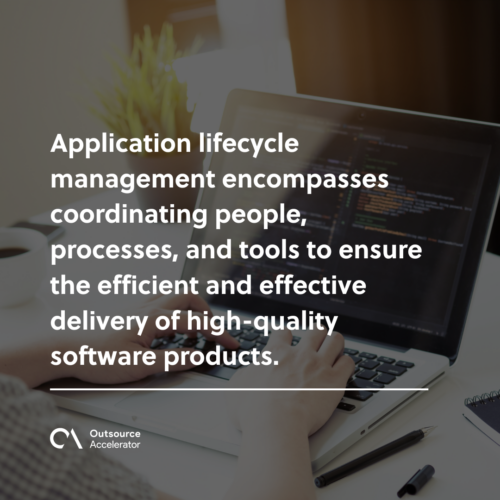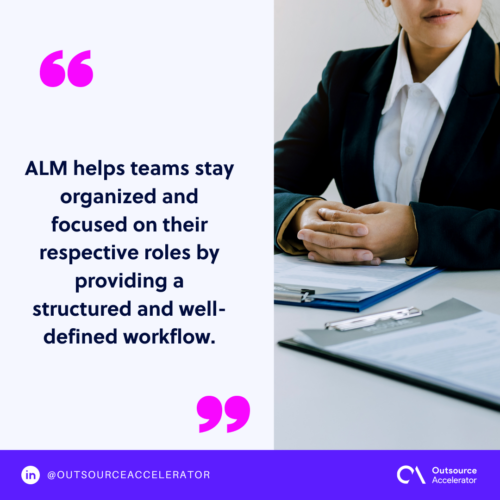A comprehensive guide to application lifecycle management

Turning to software solutions to improve business processes has become a go-to strategy for modern companies. With so many businesses relying on turnkey or custom software, the importance of developing reliable software cannot be overstated.
Thus, organizations – not just businesses – have always strived to create an optimized and efficient approach to application development. Implementing application lifecycle management or ALM is one of these approaches.
In this article, we’ll delve deeper into application lifecycle management and its relevance to developing better software.
What is application lifecycle management?
Application lifecycle management (ALM), as the name suggests, refers to managing software throughout its entire lifecycle.
From the initial concept and design to development, testing, deployment, maintenance, and eventual retirement – application lifecycle management covers all these.
ALM combines the various processes involved in software development. It encompasses coordinating people, processes, and tools to ensure the efficient and effective delivery of high-quality software products.
This approach streamlines software development by breaking it down into distinct phases. By doing this, the application lifecycle management approach provides clear guidelines for project teams to follow.
ALM’s structured approach minimizes the chances of overlooking critical tasks, reduces the risk of miscommunication, and facilitates effective project planning.

Key phases of application lifecycle management
As said earlier, application lifecycle management breaks down the software lifecycle into several phases. These phases are:
Requirements gathering
In the requirements-gathering phase, stakeholders define and document the software’s functional and non-functional requirements.
Business analysts, product managers, and end-users are the key players in this stage and play a crucial role in determining the application’s features, functionalities, and expectations.
The requirements finalized in this phase are then documented in a clear and structured manner to serve as a foundation for the subsequent phases.
Development
This phase of the application lifecycle management involves translating the requirements and planning into tangible software code.
During this phase, skilled developers write, test, and integrate the code to create the application’s functionalities and user interface. The development phase often follows agile methodologies, such as Scrum or Kanban, to encourage incremental and iterative progress.
These short development sprints allow for frequent feedback, continuous improvement, and the ability to adapt to changing requirements.
Testing and quality assurance
The testing and quality assurance phase is critical in ensuring the application meets high performance, reliability, and security standards.
At this phase, testers execute various tests, including unit testing, integration testing, system testing, and user acceptance testing, to identify defects and issues.
These testers often use automation tools to streamline the testing process, allowing for faster feedback and continuous testing during development.
Deployment
Once the application has successfully passed testing and meets the necessary quality criteria, it is ready for the application lifecycle management deployment phase.
This phase involves the process of making the application available to end-users in a live environment.
Having a well-planned deployment strategy is crucial to minimizing downtime and ensuring a smooth transition from the development phase to production.
Maintenance and updates
After the deployment phase, software applications still require ongoing maintenance and updates to address issues, add new features, and adapt to changing user needs.
Maintenance activities may include:
- Bug fixes
- Performance optimizations
- Security updates
- Database maintenance
Leveraging user feedback, monitoring tools, and analytics can give developers valuable insights that can help boost maintenance efforts and prioritize improvements.
Monitoring and feedback
Monitoring the performance, user behavior, and system metrics is vital to ensure the continuous optimal functioning of applications.
During this phase, developers can use various monitoring tools and techniques (e.g., application performance monitoring and user experience monitoring) to provide real-time insights into the application’s health and performance.
As with the previous phase, user feedback gathered through surveys, reviews, or feedback mechanisms offers valuable input. These data help identify areas of improvement to enhance user satisfaction.
End-of-life and retirement
As a software reaches the end of its lifecycle, the end-of-life and retirement phase comes in. As its name implies, this phase involves planning for the application’s retirement and end-of-life processes.
During this phase, developers systematically carry out the application’s data migration, archival, and decommissioning to ensure a smooth transition.
If a software has an incoming replacement, this will entail careful planning for the seamless migration of its users and data to the new application.
Proper execution of the end-of-life and retirement phase is crucial for:
- Maintaining data integrity
- Complying with regulatory requirements
- Ensuring a positive user experience during the transition
Challenges in implementing application lifecycle management
Implementing application lifecycle management brings many benefits to businesses. However, doing so can prove to be challenging.
Below are some of the potential obstacles you can face when implementing ALM.
Organizational resistance
As with all systemic changes in companies, implementing application lifecycle management can be met with resistance from team members and stakeholders.
Addressing this resistance requires clear communication about the benefits of ALM and providing training and support to help team members adapt to the new approach.
Businesses should also use effective change management strategies for successful implementation.
Skill gaps
Succesfully implementing application lifecycle management may require new skills and expertise from your team. For instance, adopting automated testing practices may require training testers in using testing frameworks and tools.
Addressing skill gaps may involve providing training, hiring specialized personnel, or fostering a learning culture within the organization.
Legacy systems and workflows
Similar to organizational resistance, enacting change on legacy systems and workflows can be challenging.
Organizations that have been using traditional development approaches may find it challenging to integrate ALM into existing legacy systems and workflows.
Adapting ALM to coexist with legacy processes or migrating to new ALM practices requires careful planning and may involve a phased approach to avoid disruptions.
Benefits of implementing application lifecycle management
Implementing application lifecycle management into the software development process can help businesses in many ways.
Below are some ways ALM implementation benefits companies.
Enhanced productivity
Application lifecycle management streamlines the software development process and reduces inefficiencies. ALM helps teams stay organized and focused on their respective roles by providing a structured and well-defined workflow.
Moreover, application lifecycle management encourages cross-team collaboration, increasing productivity and improving software quality.

Better collaboration
As stated above, application lifecycle management encourages cross-team communication and breaks down the silos between the various teams involved in software development.
This enhanced collaboration leads to a deeper understanding of project goals and challenges, enabling teams to make informed decisions and overcome obstacles more effectively.
Improved output quality
Application lifecycle management emphasizes testing and quality assurance at various software lifecycle stages. By implementing rigorous testing procedures, including automated testing, teams can identify and rectify defects while still in the early stages of development.
This proactive approach to quality ensures that the final product meets user expectations, functions as intended, and has fewer post-deployment issues.
Faster time to market
The structured and iterative application lifecycle management approach allows developers to deliver working software in smaller increments.
These frequent releases let organizations introduce new features and improvements faster and respond to dynamic market demands more effectively.
Moreover, the ability to deliver updates quickly gives businesses a competitive edge, as they can adapt their products to customer needs and market trends swiftly.
Risk management
Implementing application lifecycle management helps organizations identify potential risks and challenges early in the development process. This allows them to proactively address them before they can pose more serious problems.
In short, ALM helps reduce the risk of critical errors and enhance the stability of software applications.
Tools you can use for application lifecycle management
There are many software tools you can rely on when implementing application lifecycle management.
The best ones in the market include:
SpiraTeam
SpiraTeam is an all-in-one ALM software trusted by companies worldwide, particularly those in the healthcare and life sciences, financial, energy, and industrial sectors.
Cost: Starts at USD 1,717 per year for up to three concurrent users
Microsoft’s Azure DevOps Server
Microsoft has an ALM suite that utilizes Visual Studio, one of the most-used integrated development environments in the development field.
This platform is especially useful for organizations that use a .NET framework, as .NET developers tend to use Visual Studio.
Cost: USD 9,000 per year for three concurrent users (Visual Studio Enterprise) and USD 1,600 per year (Visual Studio Professional)
Application lifecycle management is a must in software development
Overall, application lifecycle management plays a crucial role in software development for several reasons.
Foremost among these reasons is that application lifecycle management provides a systematic approach to the otherwise complex processes involved in software development.
Application lifecycle management breaks down processes into smaller and more easily manageable ones. It ensures that each phase of software development is well-organized and executed.boration between the different people involved in the software development process (e.g., developers, testers, and project managers).
This promotes better communication and lessens the likelihood of misunderstandings across teams.
Additionally, application lifecycle management significantly helps mitigate the risks and issues associated with software development. Through ALM, teams can identify and proactively address potential problems early in the development process.







 Independent
Independent




